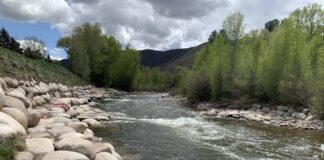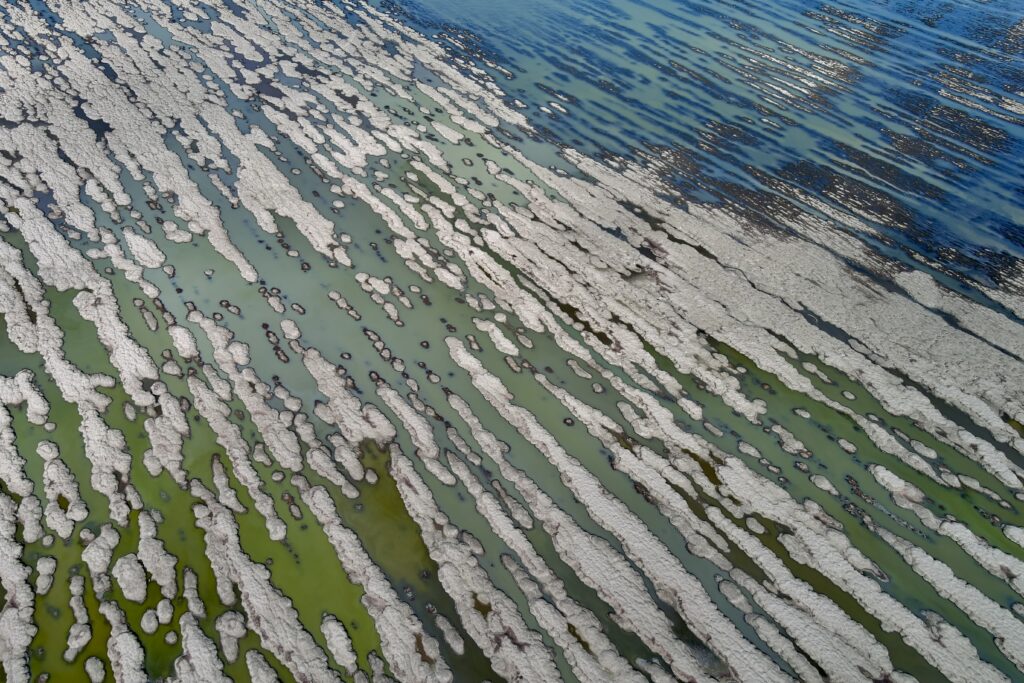
Exposed microbialite reefs create beautiful patterns at the surface of Utah’s Great Salt Lake. Credit: Photograph courtesy of the Utah Geological Survey
By Wynne Parry, bioGraphic | August 20, 2023
True to its name, the Great Salt Lake contains a great deal of salt. In the lake’s northern arm, salinity is so high that crystals spontaneously form on the surface, then sink into water tinted pink by salt-loving microbes. South of the 20-mile-long railroad causeway that divides the lake, influxes of fresh water lead to more prosaic hues of brown and green. Even there, though, the Great Salt Lake can be more than five times saltier than the ocean.
Salinity this high prevents water from freezing, corrodes and pummels boats, and increases buoyancy—perfect for people who want to float, but resistant to anyone who attempts to dive in. Should you try, and happen to open your mouth, the taste of the water reportedly calls to mind the burn of a salt lick.

A considerable snowpack and runoff this year has once again submerged the microbialite reefs left high and dry by recent drought conditions. But scientists are worried that this year’s runoff is an anomaly and that drought and high water demand will continue to threaten this ecosystem. Credit: Photograph courtesy of the Utah Geological Survey
Most living things can’t handle this salinity. There are no fish, no mollusks, not even any plants in the main body of the lake, which covered 2,300 square miles of northern Utah’s high desert in the 1980s. But paradoxically, the Great Salt Lake teems with life. Two tiny animals, brine shrimp and brine flies, thrive in its waters in enormous numbers. They in turn feed as many as 12 million migrating birds, including eared grebes (Podiceps nigricollis), red-necked phalaropes (Phalaropus lobatus), and American avocets (Recurvirostra americana).
Living in the Salt Lake Valley in the 1980s, my family had a strong connection to Utah’s wild and sometimes strange places. I grew up visiting the lake once or twice a year—more than most people I knew. With its swarms of brine flies, quicksand-like mud, and sulfurous odor, the Great Salt Lake doesn’t make for a conventional day trip. While other kids my age vacationed at Lake Powell much farther south, my family explored the shore of our local saline lake and waded in its briny waters.

Scientists survey exposed microbialite reefs at the edge of a shrinking Great Salt Lake. Credit: Photograph courtesy of the Utah Geological Survey
Over the past couple of years, however, average Utahns, as well as people elsewhere in the country and the world, have paid more attention to the Great Salt Lake. In 2021 and again in 2022, the lake’s level plunged to record-breaking lows, making headlines and raising the apocalyptic specter of a barren future lakebed, largely devoid of wildlife. In this dire scenario, winds traveling across the dry expanse will loft increasing amounts of toxic dust into nearby communities, and industries that depend on the lake will suffer, including the brine shrimp fishery, which supplies tens of millions of pounds of dormant brine shrimp eggs to fish and shrimp farms around the world.
From my current home on the East Coast, I followed news of the lake’s retraction. And with a mixture of curiosity and worry, I visited again in October 2022. At the lake’s southern edge, I looked out over a muddy, vacant marina and a vast, smooth beach. Further out, beyond a channel dredged to let boats pass, was something I had never seen over decades of visits: An exposed reef. It protruded above the mirrored water like a scab over a wound, its grey mass stretching across the horizon.
Although the reef was now high and dry, it had formed underwater, built by communities of microbes over potentially thousands of years. Here and at other sites across the lake, salt-tolerant, single-celled organisms draw calcium carbonate from the lake water and deposit it in ridges, mounds and other shapes. Like coral colonies, these structures—known as microbialites—can grow to form massive reefs. And like corals, they support entire communities of living things.
Microbialites aren’t unique to the Great Salt Lake. Researchers have documented microbes hard at work building similar structures in the protected waters of Shark Bay, Australia, in Alchichica crater lake in Mexico, and around the vent of a geothermal spring in India, to name just a few places. All of these modern microbialites belong to a primordial lineage; scientists have found fossilized ancestors that date back roughly 3 billion years.
Geologists began studying Utah’s microbialites during various dry periods in the 20th century before the lake rose and submerged them again. In recent years, as the shrinking lake has exposed progressively more barren reefs, researchers have been studying microbialites and the organisms they support to learn what an ongoing drought and demand for water might mean for this spare yet vibrant ecosystem.
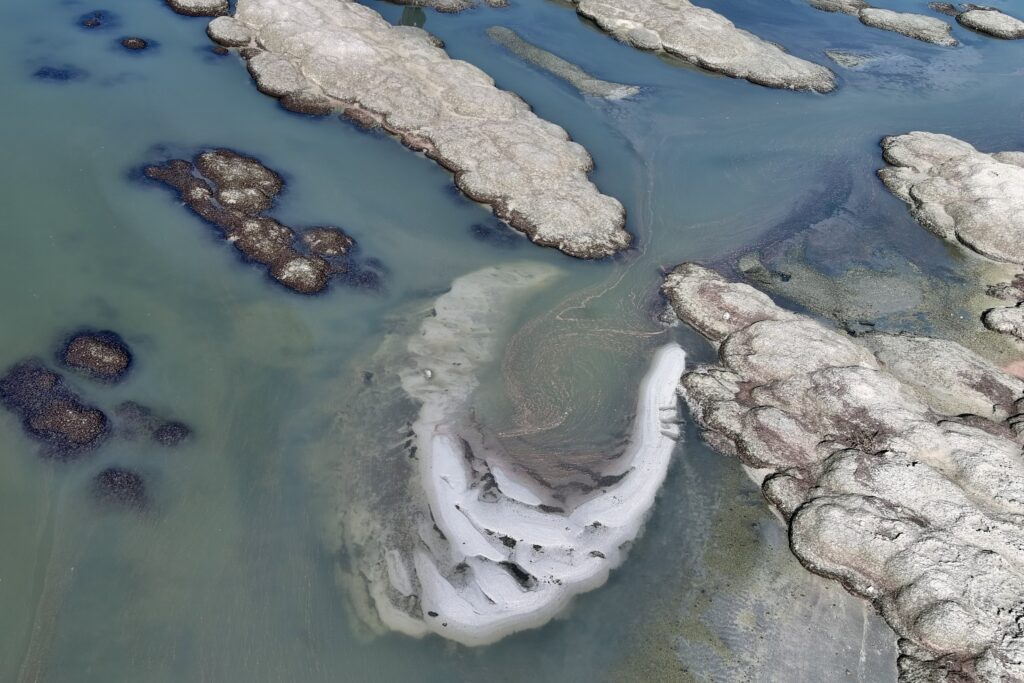
The falling water level of The Great Salt Lake has reveal many stunning patterns and countless insights, but scientists are worried about losing the microbialite reefs that help sustain this vital ecosystem should the region’s drought and rising water demand continue. Credit: Photograph courtesy of the Utah Geological Survey
The remnant of a much larger, ancient body of water known as Lake Bonneville, the Great Salt Lake receives much of its water as snowmelt from the nearby mountains. The water from most freshwater lakes eventually escapes via outlet streams to rivers and then flows to the ocean. But the Great Salt Lake, like other saline lakes around the world, is locked in its basin. With no outlet to carry minerals away, those that arrive in mountain runoff concentrate in the lake water.
The level of the Great Salt Lake typically fluctuates over the course of the year, reaching a low point in October before rebounding with spring snowmelt. But since the 19th century, homes, farms, and industries have drawn enough water from the lake’s tributaries to drive a long-term decline. The drought that’s gripped the Southwest for the past 20 years has exacerbated the situation. In fall of 2021, the lake dropped to a record low of 4,190.4 feet above sea level. When I visited in fall of 2022, it had fallen even further, to less than 4188.8 feet. Overall, it had lost more than half of its historical surface area and nearly three-quarters of its water, according to a report released in early January.
While in Utah, I accompanied a group of scientists to the lake. Much-needed snow and rain had fallen a few days earlier, and now, a porous layer of clouds blocked the sun. In groups of two, we ferried across the glassy water on a paddleboard until everyone stood atop the reef I had seen from shore. Then we fanned out across “the graveyard,” as one student described the skeletal mounds of dried microbialites beneath our feet. Further out, the exposed reef sank to meet the water, the mounds giving way to small, nearly swamped ridges that eventually faded into reflected sky.
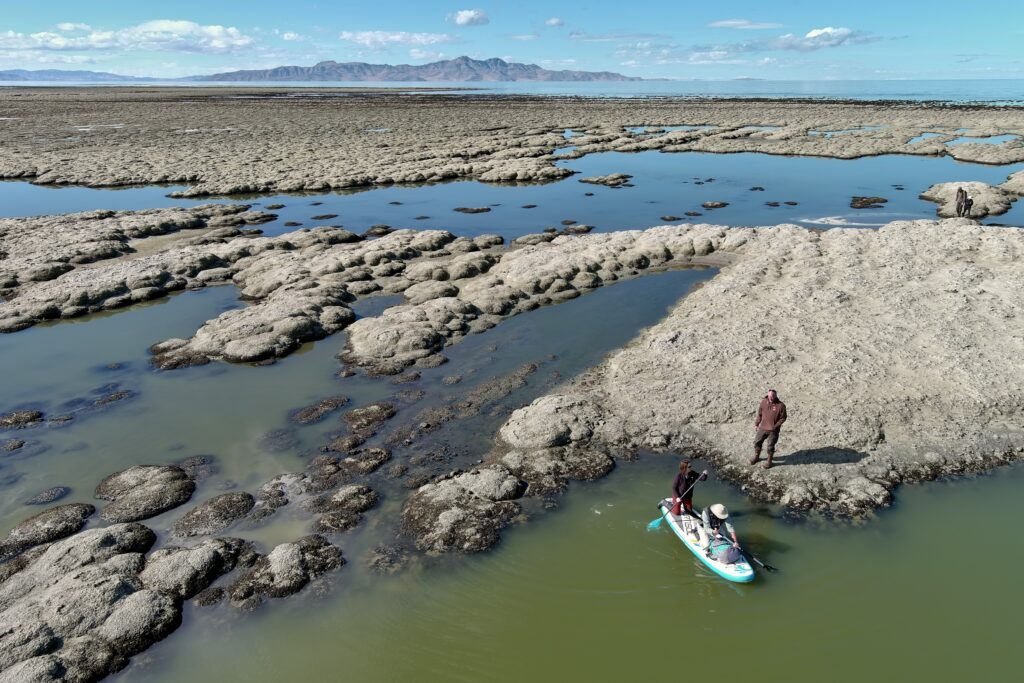
Scientists use paddle boards to move from one exposed microbialite reef to another in Utah’s Great Salt Lake. Credit: Photograph courtesy of the Utah Geological Survey
Michael Vanden Berg, a geologist and microbialite scientist with the Utah Geological Survey, gauged the history of one of the grey structures by kicking it. “I can tell you this has never been exposed before,” he said. “It’s still spongy.”
Parts of this reef likely surfaced around 1963, when the lake reached what was then its record low. Exposure to Utah’s intense sun and dry air would have hardened these tall mounds, rendering them more rocklike. In 2021, as the lake dropped below its previous record, it exposed new microbialites, including the one Vanden Berg kicked. That mound had almost certainly been growing undisturbed underwater long before Mormon settlers began recording lake levels in the mid-19th century.
When reefs are submerged, the living microbes that built them coat their surface. But marooned above the water, the organisms die within about two weeks, Vanden Burg told me. This reef was already thoroughly desiccated, the heat and sun leaving behind only stony remains. Yet at the foot of the mounds and nearly covering the low ridges, I saw remnants of the reef’s living skin; it was dark and knobby, with a rusty hue.
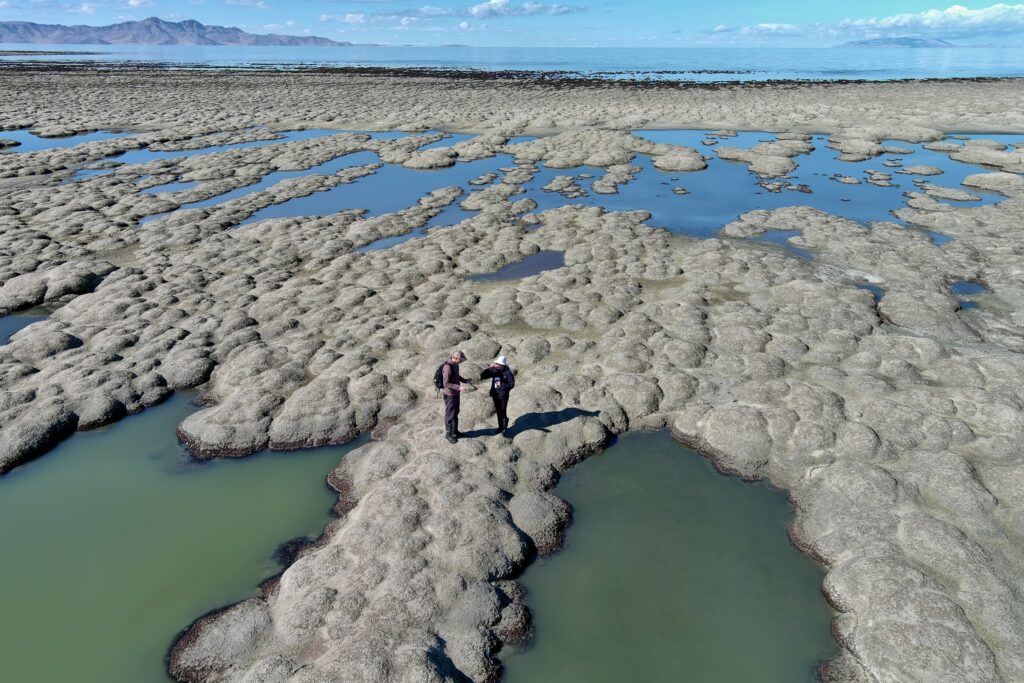
Scientists discuss the state of exposed microbialite reefs in Utah’s Great Salt Lake. Credit: Photograph courtesy of the Utah Geological Survey
This layer might look like unremarkable crud, but it contains hundreds of species of bacteria, archaea, fungi, and silica-shelled algae called diatoms. The members of the mat include Navicula, a diatom shaped like a boat viewed from below, and Euhalothece, a kind of cyanobacteria—the group of organisms that invented photosynthesis. Euhalothece and other photosynthetic microbes turn sunlight and carbon dioxide into food for other living things in the lake. Not only does photosynthesis aerate water with the oxygen it produces as a byproduct, it also changes the water chemistry in such a way that granules of the mineral calcium carbonate can form. Those granules, plus other bits of debris, adhere to the sticky goo that Euhalothece secretes. In this way, the stony structure beneath the mat accumulates and grows over millennia.
Rob Baskin, a hydrologist who’s since retired from the U.S. Geological Survey, is among the few people who have seen this underwater ecosystem firsthand. Nearly two decades ago, Baskin began mapping the contours of the lake bottom. His sonar revealed unexpected rough patches. He had read about microbialites in research published in 1938 and suspected they might be responsible. Putting on his SCUBA gear with extra weight to counteract the lake’s increased buoyancy, he dove down for a look.
Underwater, he found mounds like those I had stood on, but instead of barren and gray, they were a dark, dense green and bore dozens of pale, wormy brine fly larvae. Tiny brine shrimp swam nearby. Gas bubbles, presumably oxygen, clung to the living reef.
“It was just”—he paused and exhaled sharply—an “ecstasy of motion.”
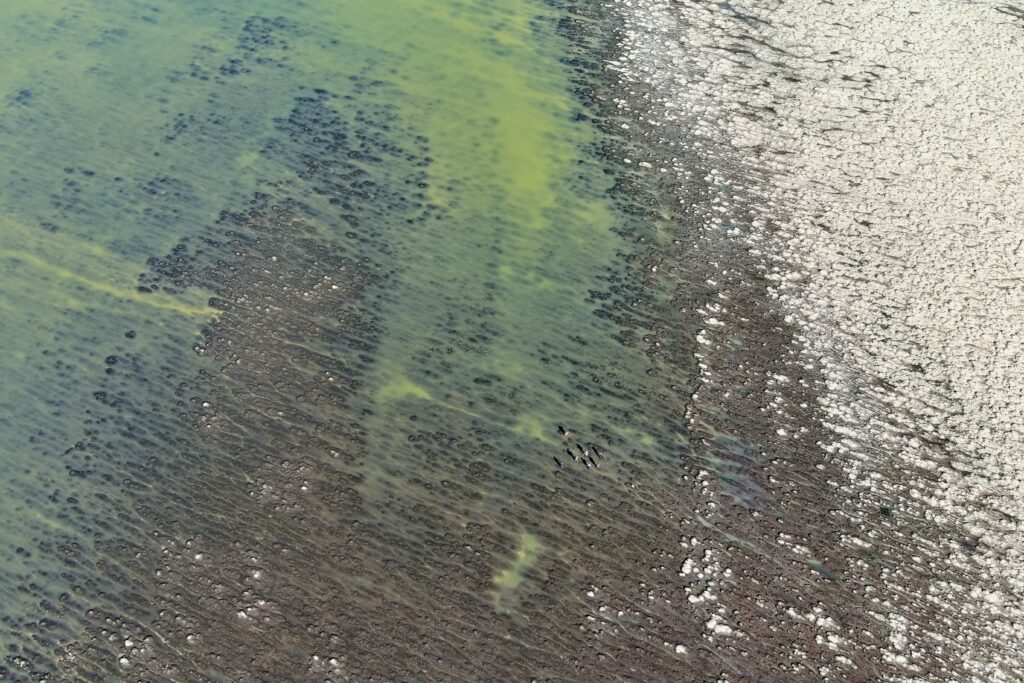
Scientists wade among partially submerged microbialites at the edge of Utah’s Great Salt Lake. Credit: Photograph courtesy of the Utah Geological Survey
Eleven years after Baskin’s dive, when I visited the lake, he suspected that the swarm of life he encountered had gone still. Researchers estimate that in the summer of 2022, receding water left up to half of the microbialites in the lake’s southern arm to dry out, with consequences that will likely reverberate up the food chain.
Brine fly larvae rely on the microbialites for shelter and also eat their microbes. Brine shrimp, meanwhile, feed primarily on microbes in the water, but they too munch those that form the microbialite’s living skin. The flies and shrimp, in turn, nourish resident wildlife like the California gull (Larus californicus), as well as the roughly 330 species of migrating birds that stop here.
The receding lake’s ever more concentrated salt content has already pushed salt-tolerant organisms closer to their limits. All the microbialite-building communities in the northern half of the lake, for example, are dead. And scientists have suspected that the increase in salinity and the desiccation of microbialites are squeezing brine flies. During the summer, brine flies typically rise in clouds around the feet of anyone walking along the shore. Second only to the lake’s distinctive smell, the flies are perhaps the thing Utahns most love to hate about the lake—until recently.

A group of gulls lifts off over The Great Salt Lake in Utah. Credit: Photograph by Jason Finn / Shutterstock

A California gull, feasts on brine flies at the edge of Mono Lake in California, another key stopover for migrating birds. Credit: Photograph by Farjana.rahman / Shutterstock

Brine flies gather in abundance at the edge of and on the surface of the Great Salt Lake, providing much needed food for migrating birds. Credit: Photograph by Floris van Breugel
“We haven’t seen flies in any number for months,” biologist and Great Salt Lake Institute director Bonnie Baxter told me when I met with her in October of 2022. “This summer has just been eerie.”
To get a better handle on the flies’ fate, Baxter had invited David Herbst, a self-described “salt lake junkie” and freshwater ecologist and physiologist at the University of California-Santa Barbara, to join the expedition. Standing with Vanden Berg, Baxter, and other scientists atop a partially submerged reef, Herbst swept his foot through the water. Like caterpillars metamorphosing into butterflies, brine fly larvae anchor themselves to microbialites to form pupae. “There should be hundreds of pupae floating to the surface,” he explained. “There’s none, or at least very, very few, and those that are [here] are not looking viable.” The few that did rise resembled elongated grains of dark rice; many appeared too small to produce adults.
The loss of brine flies will inevitably impact the birds that eat them, says John Luft, the Great Salt Lake ecosystem program manager at the Utah Division of Wildlife Resources. When Luft’s group and the National Audubon Society examined data on 37 bird species collected over 21 years, they saw a significant decline in only one, the redhead duck (Aythya americana). But preliminary data suggest bigger declines may be on the horizon, and Luft and others worry that the relatively stable bird populations in the Great Salt Lake region may conceal the impact of lost water and food, here and elsewhere.
“We often hear that, oh, the birds can just go somewhere else. But really, when all the saline wetlands and lakes of the West are experiencing this problem… I fear that certain species are going to see declines.”
— Heidi Hoven, Audubon
The Great Salt Lake belongs to a network of saline water bodies across the western U.S. that provide critical habitat for millions of migrating shore and water birds, including 90 percent of Wilson’s phalaropes (Phalaropus tricolor) and 99 percent of the North American population of eared grebes. Overconsumption of water and protracted drought are also shrinking the smaller lakes in the network, potentially forcing some birds to reroute to the Great Salt Lake and thus masking local changes. Thanks to its size, the Great Salt Lake “is kind of the last place available,” Luft told me. Overall, populations of migrating shorebirds, which depend on these salty oases, have dropped nearly 70 percent since 1973, according to Audubon.
“We often hear that, oh, the birds can just go somewhere else,” said Heidi Hoven, a conservation specialist at an Audubon sanctuary on the lake’s southern shore. “But really, when all the saline wetlands and lakes of the West are experiencing this problem of drying up, I really fear that certain species are going to see declines in their populations.”

An American avocet forages near Swan Lake Refuge in Lemmon Valley. Nevada. Credit: Photograph by Diane McAllister
Although people have lived in what’s now northern Utah for thousands of years, human demand for the region’s scarce water didn’t become significant until around 1847, when Mormon pioneers began diverting it for farming. Today, agriculture remains the largest user, removing 1.3 million acre-feet annually that would have flowed into the lake. In contrast, homes, businesses, and industries use just 381,000 acre-feet. Altogether, human uses of tributary water account for a decline of roughly 12 feet in the Great Salt Lake’s level, according to David Tarboton, a hydrologist at the Utah Water Research Laboratory. Natural variability in weather explains the loss of another four feet, while warming caused by climate change appears responsible for a drop of more than one foot.
The effects extend beyond biodiversity and into the region’s human communities. Already, winds sweeping across patches of the empty lakebed pick up dust, some of which contains carcinogenic arsenic, and loft it all over northern Utah. Researchers don’t yet know the degree to which the dust affects human health, but it poses one more risk in a region already beset with air quality problems. As the protective crust covering the empty lakebed breaks down, these dust plumes will likely worsen.
The drying also threatens industries. By one calculation, the lake contributes nearly $2.5 billion to Utah’s economy through its brine shrimp fishery, mineral extraction, recreation (the lake is a destination for bird watchers, among others), and through evaporation, which provides moisture that forms clouds and falls as snow on the famous ski resorts in nearby mountains.

Tiny brine shrimp like these serve as a critical food source for migrating birds and other creatures. Credit: Photograph by Jan Hamrsky
Leaders in this desert state have long known they need to better manage its water, including that bound for the Great Salt Lake. But their efforts have recently taken on new urgency.
During the state legislature’s 2022 session, elected officials approved an unprecedented set of measures to support water conservation and related infrastructure. Appropriations made that spring and during the 2023 session have funded efforts to help farmers grow their crops with less water. That money will support tracking the amount of water used for lawns and gardens, as well, and establish a commissioner’s office to coordinate efforts to protect the lake. Legislators also tweaked water law to allow farmers to conserve water without fear of losing their water rights, changes that give them the option of leasing water that they save to a new trust created to acquire water for the Great Salt Lake.
Even if successful, changes like these probably won’t deliver a significant amount of water to the lake for some time. Meanwhile other measures, including one that would have set a target lake level, failed, much to the frustration of environmental advocates.
In a stroke of luck, though, plenty of rain and snow made this past winter one of the wettest on record. Six months after my October visit, the lake level had risen about three feet. Tarboton expects it to rise more this year, but even so, it will likely be three feet shy of the low end of its optimal range.
“What happens after that depends on what we do in terms of conservation,” Tarboton told me, “and what happens with the climate in future years.”
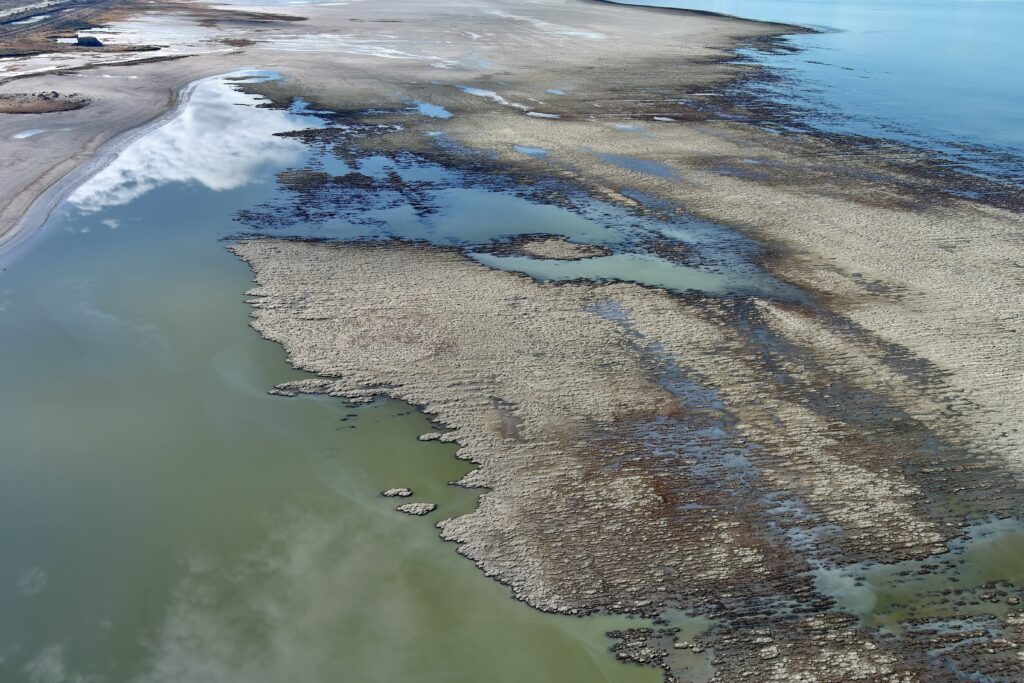
Microbialites, some submerged and growing in the The Great Salt Lakes for millennia, dry out in the early spring sunshine, victims of recent drought and growing water demand in the region. Credit: Photograph courtesy of the Utah Geological Survey
On March 11, 2023, I visited the marina again. Snow covered the mountains and still mottled the lower elevations, and the influx of spring melt had submerged much—but not all—of the reef I had walked on in the fall. The tallest mounds remained clustered above the surface like an archipelago, breaking up ripples driven by a soft wind.
I wondered about the microbialites that had again disappeared beneath the water. History suggests—and researchers’ experiments confirm—that microbial mats can return even after prolonged exposure to air. In the years following the parched summer of 1963, which temporarily exposed some microbialites, those that submerged again “redeveloped a really nice, thick microbial mat,” Vanden Berg had told me. Like all desert creatures, the microbes in the Great Salt Lake have some built-in resilience to drought.
But ensuring the long-term health of the ecosystem they support requires water, and a lot of it. One wet season, even an exceptional one, isn’t enough without other, more drastic changes in how people consume water—and how much fossil fuel we burn. Still, looking out over the gently moving water, a silvery mirror to the sky’s rich blue and cottony white, I found it hard to imagine an end to the Great Salt Lake, or to the flurry of life hidden beneath its surface.
Wynne Parry is a freelance writer whose work focuses on science and the natural world. A former Utahn, she has traded that state’s desert and mountains for the streams and woods of Pennsylvania. You can find more of her work at wynne-parry.com.
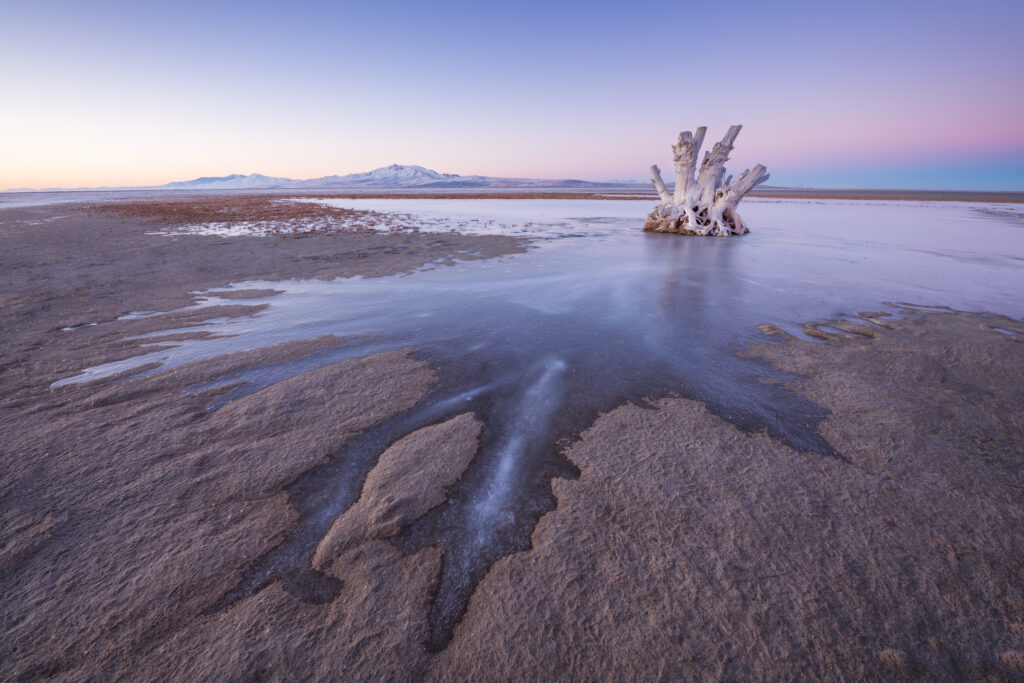
Tree stump on ice in Antelope Island at dawn. Credit: Photography by kojihirano / Shutterstock
The Water Desk’s mission is to increase the volume, depth and power of journalism connected to Western water issues. We’re an initiative of the Center for Environmental Journalism at the University of Colorado Boulder.





